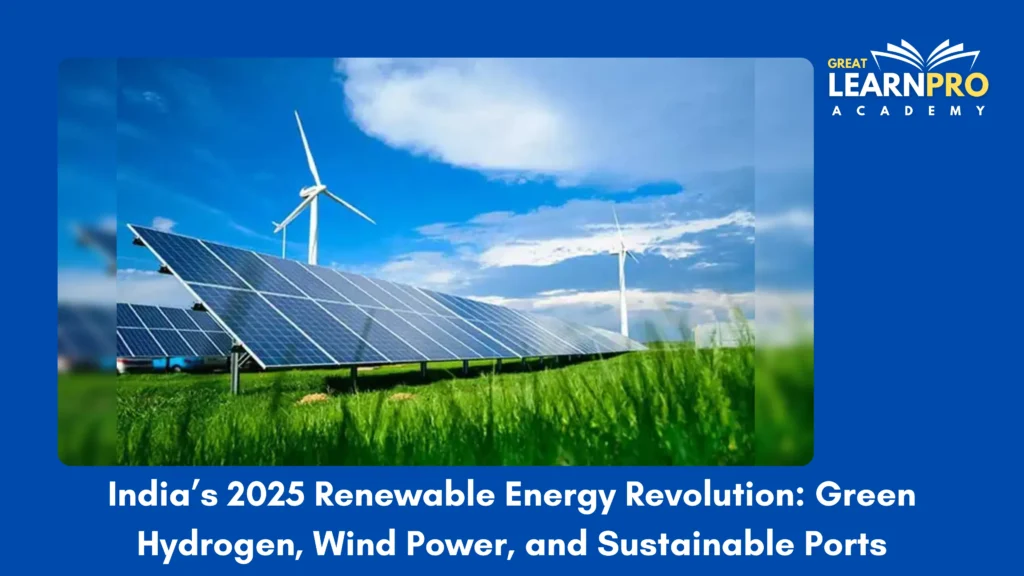In recent years, India has emerged as a key global player in the transition towards clean and sustainable energy. As the country strives to meet its commitment of achieving net-zero emissions by 2070, 2025 has seen significant progress in expanding renewable energy infrastructure, including green hydrogen projects, offshore wind farms, and eco-friendly ports. These initiatives collectively mark India’s transformation from a fossil-fuel-dependent economy to a hub of green innovation.

1. National Green Hydrogen Mission: Powering the Future
The Government of India launched the National Green Hydrogen Mission (NGHM) in January 2023, but 2025 has witnessed its large-scale implementation. With a total outlay of ₹19,744 crore, the mission aims to produce 5 million metric tonnes (MMT) of green hydrogen annually by 2030. This year, the Ministry of New and Renewable Energy (MNRE) approved the first phase of Green Hydrogen Hubs at Paradip (Odisha), Kandla (Gujarat), and Tuticorin (Tamil Nadu). These ports are being developed to handle hydrogen exports, storage, and ammonia conversion facilities.
In addition, private companies like Reliance Industries, Adani New Industries Limited, and ReNew Power have announced major hydrogen projects. Reliance’s Jamnagar Green Hydrogen Valley aims to produce 100,000 tonnes per annum by 2026, while Adani’s project in Gujarat focuses on green hydrogen-derived fertilizers. These developments position India as one of the leading global producers of clean fuel.
2. Expansion of Wind and Solar Power
India’s renewable energy capacity surpassed 190 GW in 2025, with wind and solar power contributing the lion’s share. The Gujarat Hybrid Renewable Energy Park, one of the largest in the world, integrates 30 GW of solar and wind capacity across the Kutch desert. Similarly, Tamil Nadu and Karnataka have become major wind power states, hosting some of the largest onshore wind farms in Asia.
The Union Cabinet recently cleared the Offshore Wind Energy Policy 2025, targeting 10 GW of offshore wind capacity by 2030. Pilot projects are underway off the coasts of Gujarat and Tamil Nadu, with international collaborations involving Denmark, the UK, and Japan. This marks India’s first step into tapping the enormous potential of its 7,500 km coastline for clean energy generation.
3. Green Ports and Shipping: A Blueprint for Maritime Sustainability
India’s major ports are transitioning into green hydrogen and renewable energy hubs under the Harit Sagar Green Port Guidelines 2023. By 2025, ports such as Kandla, Cochin, and Vizag have started using shore power, solar rooftops, and LNG-based tugs to cut emissions. The Sagarmala Programme now integrates decarbonization measures, including solarized port operations and waste-to-energy plants at coastal zones.
Furthermore, the Ministry of Ports, Shipping and Waterways has initiated a pilot to power cargo vessels using green hydrogen, making India among the few countries testing hydrogen-fueled maritime operations. The goal is to ensure that at least 50% of major ports become carbon-neutral by 2030.
4. Electric Mobility and Urban Green Transition
India’s clean energy transition extends beyond industry and ports into transportation. Under the FAME II (Faster Adoption and Manufacturing of Hybrid and Electric Vehicles) scheme, over 1.5 million electric vehicles have been subsidized till 2025. Cities like Delhi, Pune, and Bengaluru are expanding their EV charging infrastructure with over 20,000 fast-charging stations nationwide.
The government has also announced the National Green Mobility Mission, focusing on electrifying public transport and promoting hydrogen fuel cell buses. The integration of green hydrogen into mobility aims to reduce dependency on imported crude oil while cutting carbon emissions drastically.
5. Global Leadership and Climate Diplomacy
At the COP29 Summit (2024) and the subsequent G20 Green Energy Dialogue (2025), India reaffirmed its leadership role by calling for a Global South Green Transition Fund. Prime Minister Narendra Modi emphasized that developing countries should not merely be consumers of clean technology but co-creators. India’s International Solar Alliance (ISA), now comprising over 120 member countries, continues to promote affordable solar energy across Africa, Asia, and Latin America.
Conclusion
India’s comprehensive approach combining policy innovation, technological advancement, and international collaboration reflects a clear vision for a sustainable future. The focus on green hydrogen, wind energy, and carbon-neutral ports underscores the nation’s determination to redefine its energy landscape. As India moves steadily towards its Panchamrit goals and net-zero target, it stands not only as a model for emerging economies but also as a global leader in renewable transformation.
Sources:
- https://infra.economictimes.indiatimes.com/news/ports-shipping/india-unveils-first-1-mw-green-hydrogen-plant-at-deendayal-port/123019046?utm_
- https://fchea.org/hydrogen-country-update-india/
- https://m.economictimes.com/industry/transportation/shipping-/-transport/deendayal-port-authority-in-kandla-aims-for-global-maritime-leadership-with-green-fuel-push-dpa-chairperson/articleshow/123319108.cms
- https://www.reuters.com/world/india/india-eyes-green-hydrogen-bunkering-major-ports-by-2035-2023-05-10/?utm_
More Current affairs: https://learnproacademy.in/updates/
